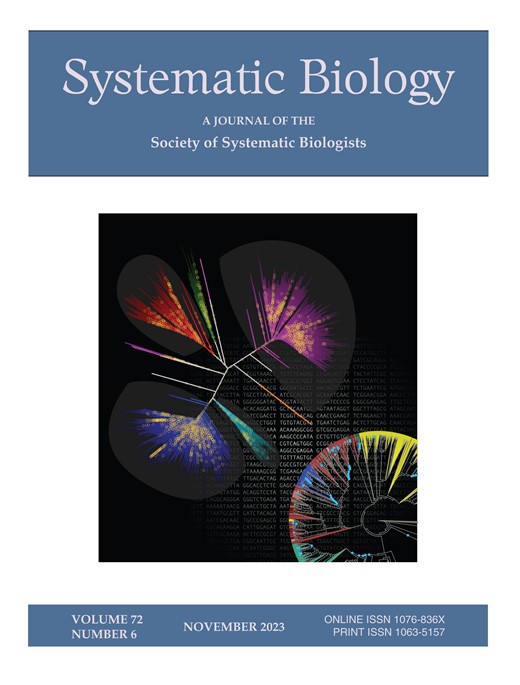复杂的多倍体:起源、基因组组成和外来等位基因的作用
IF 6.1
1区 生物学
Q1 EVOLUTIONARY BIOLOGY
引用次数: 0
摘要
外来入侵使多倍体物种能够从二倍体祖先或其他不相关的二倍体或多倍体品系中获得新的基因组内容,从而促进遗传多样性,促进适应性等位基因的发现。在某些情况下,高水平的引种会导致从多倍体祖先物种继承的大量等位基因被替换,从而深刻改变多倍体的基因组组成。在这种复杂的多倍体中,通常很难确定哪些类群是祖先物种,哪些类群通过随后的杂交提供了额外的导入块。在本文中,我们利用种群级基因组数据重建了桦树(Betula pubescens)的系统发育历史,桦树是一个四倍体物种,通常被假定为起源于全多倍体,已知至少与其他四个桦树物种杂交。为此,我们在多物种凝聚下建立了多倍体化和引种事件模型,然后使用近似贝叶斯计算剔除算法来评估和比较相互竞争的多倍体化模型。我们提供的证据表明,B. pubescens 是 B. pendula 及其现生姊妹种 B. platyphylla 的共同祖先在大约 178,000-188,000 代前发生的自倍基因组加倍事件的结果。在自多倍体化之后,B. pubescens与B. pendula、B. nana和B. humilis发生了广泛杂交,这些物种对B. pubescens基因组的相对贡献在整个物种分布区有明显差异。对含有从B. nana导入的等位基因的B. pubescens基因座进行的功能分析发现了多个参与气候适应的基因,而含有从B. humilis导入的等位基因的基因座则发现了多个参与调节植物物种减数分裂稳定性和花粉活力的基因。本文章由计算机程序翻译,如有差异,请以英文原文为准。
Complex Polyploids: Origins, Genomic Composition, and Role of Introgressed Alleles
Introgression allows polyploid species to acquire new genomic content from diploid progenitors or from other unrelated diploid or polyploid lineages, contributing to genetic diversity and facilitating adaptive allele discovery. In some cases, high levels of introgression elicit the replacement of large numbers of alleles inherited from the polyploid’s ancestral species, profoundly reshaping the polyploid’s genomic composition. In such complex polyploids, it is often difficult to determine which taxa were the progenitor species and which taxa provided additional introgressive blocks through subsequent hybridization. Here, we use population-level genomic data to reconstruct the phylogenetic history of Betula pubescens (downy birch), a tetraploid species often assumed to be of allopolyploid origin and which is known to hybridize with at least four other birch species. This was achieved by modeling polyploidization and introgression events under the multispecies coalescent and then using an approximate Bayesian computation rejection algorithm to evaluate and compare competing polyploidization models. We provide evidence that B. pubescens is the outcome of an autoploid genome doubling event in the common ancestor of B. pendula and its extant sister species, B. platyphylla, that took place approximately 178,000–188,000 generations ago. Extensive hybridization with B. pendula, B. nana, and B. humilis followed in the aftermath of autopolyploidization, with the relative contribution of each of these species to the B. pubescens genome varying markedly across the species’ range. Functional analysis of B. pubescens loci containing alleles introgressed from B. nana identified multiple genes involved in climate adaptation, while loci containing alleles derived from B. humilis revealed several genes involved in the regulation of meiotic stability and pollen viability in plant species.
求助全文
通过发布文献求助,成功后即可免费获取论文全文。
去求助
来源期刊

Systematic Biology
生物-进化生物学
CiteScore
13.00
自引率
7.70%
发文量
70
审稿时长
6-12 weeks
期刊介绍:
Systematic Biology is the bimonthly journal of the Society of Systematic Biologists. Papers for the journal are original contributions to the theory, principles, and methods of systematics as well as phylogeny, evolution, morphology, biogeography, paleontology, genetics, and the classification of all living things. A Points of View section offers a forum for discussion, while book reviews and announcements of general interest are also featured.
 求助内容:
求助内容: 应助结果提醒方式:
应助结果提醒方式:


